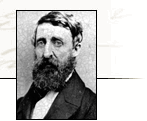

 |
 |
|||||||
|
|
||||||||
|
|
|||||||||
|
"Hardly a man takes a half hour's nap after dinner, but when he wakes he holds up his head and asks, 'What's the news?' as if the rest of mankind had stood his sentinels." ----Walden Notices of additions to this web site, and announcements of new Thoreau Edition volumes appear here. Correspondence 2: 1849-1856 (release date October 9, 2018) This is the second volume in the first full-scale scholarly edition of Thoreau's correspondence in more than half a century. When completed, the edition's three volumes will include every extant letter written or received by Thoreau--in all almost 650 letters, roughly 150 more than in any previous edition, including dozens that have never before been published. Correspondence 2 contains 246 letters, 124 written by Thoreau and 122 written to him. Sixty-three are collected here for the first time; of these, forty-three have never before been published. During the period covered by this volume, Thoreau wrote the works that form the foundation of his modern reputation. A number of letters reveal the circumstances surrounding the publication of A Week on the Concord and Merrimack Rivers in May 1849 and Walden in August 1854, as well as the essays "Resistance to Civil Government" (1849; now known as "Civil Disobedience") and "Slavery in Massachusetts" (1854), and two serialized pieces, "An Excursion to Canada" (1853) and "Cape Cod" (1855). Writing and lecturing brought Thoreau a small group of devoted fans, most notably Daniel Ricketson, an independently wealthy Quaker and abolitionist who became a faithful correspondent. The most significant body of letters in the volume are those Thoreau wrote to Harrison Gray Otis Blake, a friend and disciple who elicited intense and complex discussions of the philosophical, ethical, and moral issues Thoreau explored throughout his life. This volume contains the first publication of Thoreau's draft account of his investigation of the July 19, 1850, wreck of the barque Elizabeth, in which Margaret Fuller, her husband, Giovanni Angelo Ossoli, and their son, Eugene Angelo, drowned. See Thoreau's Account of the Wreck of the Elizabeth and the Aftermath, below, for a link to transcripts and images of the manuscripts of this account. Following every letter, annotations identify correspondents, individuals mentioned, and books quoted, cited, or alluded to, and describe events to which the letters refer. A historical introduction characterizes the letters and connects them with the events of Thoreau's life, a textual introduction lays out the editorial principles and procedures followed, and a general introduction discusses the significance of letter-writing in the mid-nineteenth century and the history of the publication of Thoreau's letters. Proper names, publications, events, and ideas found in both the letters and the annotations are included in the index, which provides full access to the contents of the volume. Robert N. Hudspeth is Research Professor of English at the Claremont Graduate University and professor emeritus of English at Redlands University. He is the editor of The Letters of Margaret Fuller and the author of Ellery Channing. Elizabeth Hall Witherell is Editor-in-Chief of The Writings of Henry D. Thoreau. Lihong Xie is Associate Textual Editor of The Writings of Henry D. Thoreau. Posted September 2018; revised March 2019 Thoreau's Account of the Wreck of the Elizabeth and the Aftermath: A discussion of the three surviving manuscript versions of Thoreau's account can be found in New Perspectives on Thoreau. Two of these versions are in Thoreau's hand: a long penciled draft, and a single leaf containing material written in ink that may have been part of a fair copy. The third, in Elizabeth Hoar's hand, is likely to be a copy of Thoreau's fair copy. The discussion is followed by links to literal transcripts and images of the manuscripts for Thoreau's penciled draft, at the Houghton Library, Harvard University, and Elizabeth Hoar's copy, in the Rare Books and Manuscripts Division, Boston Public Library. Posted March 2019; revised April 2019 Images of Thoreau Manuscripts Now Available On Line As of June 2019, twelve libraries have scanned and digitized some or all of their manuscripts by Thoreau, or of manuscript letters to him: Digital images of two of Helen Thoreau's anti-slavery scrapbooks are also available on the Abernethy Library site: Volume 3 and Volume 4. Links to letters to and from Thoreau that are included in these digital collections can be found at Correspondence 1-3. Revised March 2017, March 2019, June 2019 Images of the manuscripts of the sixteen manuscript volumes Thoreau kept from September 3, 1854, through his last entry on November 3, 1861, can now be viewed along with images of the transcripts. Thanks to Professor Kathryn Dolan and her students in the Opportunities for Undergraduate Research Experiences program at Missouri University of Science and Technology, dates of entries have been bookmarked in the images of both the manuscripts and the transcripts. If your browser does not show the navigation pane buttons when you open the link to a file, download the file (right click and print and save it as a PDF). When you open it on your computer you should see the bookmark icon among others to the left of the image of the page.
18 (September 3, 1854 - May 12, 1855) The transcripts in Online Journal Transcript are being reviewed for accuracy, and reformatted for ease of reading and better representation of significant features of the manuscripts. The new transcripts are in a proportional font, Georgia; in them, the first stage of Thoreau's composition is in 14 point type and material he added is in 11 point type. Text written in ink is black and text written in pencil is gray. To date, images of the new transcripts are available for Thoreau's manuscript volumes 18, 19, 20, and 21. Revised July 2015, March 2019 |
||||||||||
 |
||||||||||